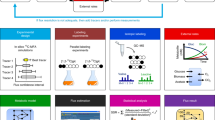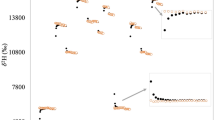Abstract
A RAPID and accurate method of determining the rate of decarboxylation activity of tissues in different types is presented. This method is based on the evolution of 14CO2 from substrate on filter papers impregnated with potassium hydroxide. Filter papers having radioactive compounds has been measured directly by liquid scintillation counting1–3.
This is a preview of subscription content, access via your institution
Access options
Subscribe to this journal
Receive 51 print issues and online access
$199.00 per year
only $3.90 per issue
Buy this article
- Purchase on Springer Link
- Instant access to full article PDF
Prices may be subject to local taxes which are calculated during checkout
Similar content being viewed by others
References
Wang, C. H., and Jones, D. E., Biochem. Biophys. Res. Comm., 1, 203 (1959).
Loftfteld, R. B., and Eigner, E. A., Biochem. Biophys. Res. Comm., 3, 72 (1960).
Funt, B. L., and Hetherington, C., Science, 131, 1608 (1960).
Operational Manual. Packard Tri-Carb Liquid Scintillation Spectrometer (Packard Instrument Co., Inc.).
Burns, J. J., Julian, K., and Dayton, P. G., J. Biol. Chem., 232, 107 (1958).
Author information
Authors and Affiliations
Rights and permissions
About this article
Cite this article
CHIRIBOGA, J., ROY, D. Rapid Method for Determination of Decarboxylation of Compounds labelled with Carbon-14. Nature 193, 684–685 (1962). https://doi.org/10.1038/193684a0
Issue Date:
DOI: https://doi.org/10.1038/193684a0
This article is cited by
Comments
By submitting a comment you agree to abide by our Terms and Community Guidelines. If you find something abusive or that does not comply with our terms or guidelines please flag it as inappropriate.



